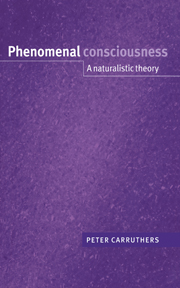Book contents
- Frontmatter
- Contents
- List of figures
- Preface
- 1 Assumptions, distinctions, and a map
- 2 Perspectival, subjective, and worldly facts
- 3 Explanatory gaps and qualia
- 4 Naturalisation and narrow content
- 5 First-order representationalism
- 6 Against first-order representationalism
- 7 Higher-order representationalism: a first defence
- 8 Dispositionalist higher-order thought theory (1): function
- 9 Dispositionalist higher-order thought theory (2): feel
- 10 Phenomenal consciousness and language
- 11 Fragmentary consciousness and the Cartesian theatre
- Conclusion
- References
- Author index
- Subject index
9 - Dispositionalist higher-order thought theory (2): feel
Published online by Cambridge University Press: 30 September 2009
- Frontmatter
- Contents
- List of figures
- Preface
- 1 Assumptions, distinctions, and a map
- 2 Perspectival, subjective, and worldly facts
- 3 Explanatory gaps and qualia
- 4 Naturalisation and narrow content
- 5 First-order representationalism
- 6 Against first-order representationalism
- 7 Higher-order representationalism: a first defence
- 8 Dispositionalist higher-order thought theory (1): function
- 9 Dispositionalist higher-order thought theory (2): feel
- 10 Phenomenal consciousness and language
- 11 Fragmentary consciousness and the Cartesian theatre
- Conclusion
- References
- Author index
- Subject index
Summary
In this chapter we come to the crux. I shall examine how the competing higher-order accounts can explain the defining feature of phenomenal consciousness – namely its subjective feel, or ‘what-it-is-likeness’ – and I shall give a final adjudication between them on this ground. I shall argue that each of the two forms of higher-order thought (HOT) theory – in contrast with higher-order experience (HOE) theory – can advance essentially the same (fully successful) reductive explanation of phenomenal consciousness. In which case, given the strength of the arguments which we were able to deploy in chapter 8 on behalf of dispositionalist forms of HOT theory, it is the latter which should emerge as the overall winner.
HOE theory and feel
I argued at some length in chapter 8:1 that higher-order experience (HOE) theory is highly implausible, from both functional and evolutionary perspectives. In the present section I shall consider whether those disadvantages might nevertheless be outweighed by the capacity of HOE theory to explain the subjective feel of experience. My answer will be negative.
The transparency objection
An objection which is often made against HOE theory is as follows (e.g. Dretske, 1995). If HOE theory were true, then how is it that there is no phenomenology distinctive of inner sense, in the way that there is a phenomenology associated with each outer sense? Since each of the outer senses gives rise to a distinctive set of phenomenological properties, you might expect that if there were such a thing as inner sense, then there would also be a phenomenology distinctive of its operation.
- Type
- Chapter
- Information
- Phenomenal ConsciousnessA Naturalistic Theory, pp. 236 - 270Publisher: Cambridge University PressPrint publication year: 2000



